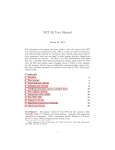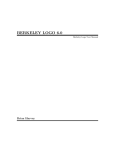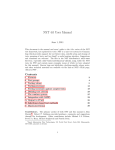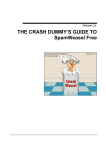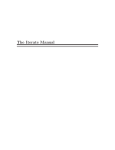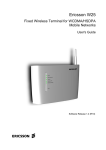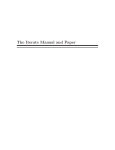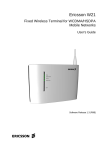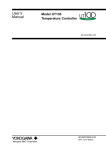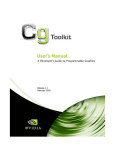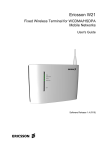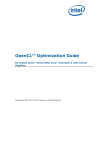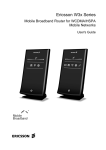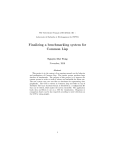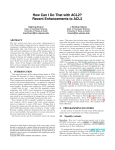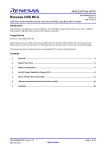Download NST 2.1 User Manual
Transcript
NST 2.1 User Manual July 1, 2010 This document is the manual and users’ guide to the 2.1.x series of the NST test framework. NST is a unit test system for Common Lisp which provides support for test fixture data, stateful setup and cleanup of tests, grouping of tests, and (we think!) a useful runtime interface. Suggestions and comments are welcome; a list of known bugs and infelicities concludes this document. The files in the NST distribution’s self-test directory, especially self-test/core/builtin-checks.lisp, holds the NST tests for NST and contain many examples (some of which we have adapted for this manual). Contents 1 Fixtures 2 2 Test groups 3 3 Tests and test criteria 4 4 Defining test criteria 12 5 Verifying invariants against sampled data 16 6 The runtime system 21 7 Integration with ASDF 23 A The NST API 27 B Output to JUnit 29 C Issues, bugs and enhancements 29 Contributors. The primarily author of both NST and this manual is John Maraist1 . Robert P. Goldman provided guidance, comments and suggestions through the development. Other contributors include Mike Pelican, Steve Harp and Michael Atighetchi. 1 Smart Information Flow Technologies, 211 North First Street, Suite 300, Minneapolis, MN 55401; jmaraist at sift.info. 1 Fixtures Fixtures are data structures and values which may be referred to by name during testing. NST provides the ability to use fixtures across multiple tests and test groups, and to inject fixtures into the runtime namespace for debugging. A set of fixtures is defined using the def-fixtures macro: (def-fixtures FIXTURE-NAME ([ :uses USES ] [ :assumes ASSUMES ] [ :outer OUTER ] [ :inner INNER ] [ :documentation DOCUMENTATION ] [ :cache FLAG ] [ :export-names FLAG ] [ :export-fixture-name FLAG ] [ :export-bound-names FLAG ]) ([ ([ :cache FLAG ]) ] NAME FORM) ([ ([ :cache FLAG ]) ] NAME FORM) ... ([ ([ :cache FLAG ]) ] NAME FORM)) FIXTURE-NAME is the name to be associated with this set of fixtures. USES is a list of the names of other fixture sets which this declaration assumes to be available. This declaration is optional, but will supress some warnings. OUTER and INNER are lists of declarations to be included in a declare statement respectively outside and inside of the let-binding in which the BINDINGS are applied. DOCUMENTATION describes the fixture set. When a fixture is attached to a test or test group, each NAME defined in that fixture becomes available in the body of that test or group as if let*-bound to the corresponding FORM. A fixture in one set may refer back to other fixtures in the same set (again à la let*) but forward references are not allowed. The names of a fixture and the names it binds can be exported from the package where the fixture is defined using the export-bound-names and export-fixture-name arguments. The default value of both is nil unless a non-nil value is provided for export-names. The cache option, if non-nil, directs NST to evaluate a fixture’s form one single time, and re-use the resulting value on subsequent applications of the fixture. Note that if this value is mutated by the test cases, test behavior may become unpredictable! However this option can considerably improve performance when constant-valued fixtures are applied repeatedly. Caching may be set on or off (the default is off) for the entire fixture set, and the setting may vary for individual fixtures. Examples of fixture definitions: 2 (def-fixtures f1 () (c 3) (d ’asdfg)) (def-fixtures f2 (:uses (f1)) (d 4) (e ’asdfg) (f c)) (def-fixtures f3 () ((:cache t) g (ackermann 1 2)) ((:cache nil) h (factorial 5))) To cause a side-effect among the evaluation of a fixture’s name definitions, nil can be provided as a fixture name. In uses of the fixture, NST will replace nil with a non-interned symbol; in documentation string such as for :whatis, any nils are omitted. The with-fixtures macro faciliates debugging and other non-NST uses of fixtures sets: (with-fixtures (FIXTURE ... FIXTURE) FORM ... FORM) This macro evaluates the forms in a namespace expanded with the bindings provided by the fixtures. 2 Test groups Groups of tests can be associated with fixture sets, stateful initiatization, and stateful cleanup. The syntax of a test group declaration is: (def-test-group NAME (FIXTURE FIXTURE ... FIXTURE) [ (:setup FORM FORM ... FORM) ] [ (:cleanup FORM FORM ... FORM) ] [ (:fixtures-setup FORM FORM ... FORM) ] [ (:fixtures-cleanup FORM FORM ... FORM) ] [ (:each-setup FORM FORM ... FORM) ] [ (:each-cleanup FORM FORM ... FORM) ] [ (:documentation STRING) ] TEST TEST ... TEST) 3 NAME is the name of this test group. The FIXTUREs are to be applied to the tests in this group. The :setup forms are run after inclusion of names from fixture sets, but before any tests from the group. Individual tests should make no assumptions as to whether the setup is unique to that test, or whether it is shared among several tests of that group. The :cleanup forms are normally run after the setup completes; however the cleanup form will not be run if the setup form raises an error. When the user asks the runtime system to enter the debugger on an error, the cleanup form will not run unless the user explicitly enabled a resumption of the test routine from the debugger. The cleanup form will be run in other circumstances, including at a user-requested break in testing at either failure or error. The :fixtures-setup (respectively :fixtures-cleanup) form is run before fixtures are bound (after their bindings are released). These forms are useful, for example, to initialize a database connection from which the fixture values are drawn. The :each-setup and :each-cleanup forms are run before each test, rather than once for the group. The :documentation form sets the docstring for the class. 3 Tests and test criteria Individual unit tests are encoded with the def-test form: (def-test (NAME [ :group GROUP-NAME ] [ :setup FORM ] [ :cleanup FORM ] [ :fixtures (FIXTURE FIXTURE ... FIXTURE) ] [ :documentation STRING ] ) criterion FORM FORM ... FORM) (def-test NAME criterion FORM FORM ... FORM) The SETUP, CLEANUP and FIXTURES are just as for test groups, but apply only to the one test. The CRITERION is a list or symbol specifying the properties which should hold for the FORMs. When a test is not enclosed within a group body, a group name must be provided by the GROUP option. When a test is enclosed within a group body, the GROUP 4 option is not required, but if provided it must agree with the group name. When there are no SETUP, CLEANUP or FIXTURES arguments, the NAME may be given without parentheses. Likewise, any criterion consisting of a single symbol, e.g. (:pass), may be abbreviated as just the symbol without the parentheses, e.g. :pass. The :documentation form provides a documentation string in the standard Lisp sense. Since documentation strings are stored against names, and since the same name can be used for several tests (so long as they are all in different packages), documentation strings on tests may not be particularly useful. The def-check form is a deprecated synonym for def-test. 3.1 3.1.1 Basic criteria The :true criterion The form is evaluated at testing time; the criterion requires the result to be non-nil. Syntax: :true 3.1.2 The :eq criterion The criterion argument and the form under test are both evaluated at testing time; the criterion requires that the results be eq. Syntax: (:eq FORM) Example: (def-test eq1 (:eq ’b) (cadr ’(a b c))) 3.1.3 The :symbol criterion The form under test is evaluated at testing time. The criterion requires that the result be a symbol which is eq to the symbol name given as the criterion argument. Syntax: (:symbol NAME) Passing example: (def-test sym1 (:symbol a) (car ’(a b c))) Failing example: (def-test sym1x (:symbol a) (cadr ’(a b c))) 3.1.4 The :eql criterion The criterion argument and the form under test are both evaluated at testing time; the criterion requires that the results be eql. Syntax: (:eql FORM) Example: (def-test eql1 (:eql 2) (cadr ’(1 2 3))) 5 3.1.5 The :equal criterion The criterion argument and the form under test are both evaluated at testing time; the criterion requires that the results be equal. Syntax: (:equal FORM) 3.1.6 The :equalp criterion The criterion argument and the form under test are both evaluated at testing time; the criterion requires that the results be equalp. Syntax: (:equalp FORM) 3.1.7 The :forms-eq criterion The two forms under test are both evaluated at testing time; the criterion requires that the results be eq. Syntax: :forms-eq Example: (def-test eqforms1 :forms-eq (cadr ’(a b c)) (caddr ’(a c b))) 3.1.8 The :forms-eql criterion The two forms under test are both evaluated at testing time; the criterion requires that the results be eql. Syntax: :forms-eql Example: (def-test eqlforms1 :forms-eql (cadr ’(a 3 c)) (caddr ’(a c 3))) 3.1.9 The :forms-equal criterion The two forms under test are both evaluated at testing time; the criterion requires that the results be equal. Syntax: :forms-equal 3.1.10 The :predicate criterion The criterion argument is a symbol (unquoted) or a lambda expression; at testing time, the forms under test are evaluated and passed to the denoted function. The criterion expects that the result of the function is non-nil. Syntax: (:predicate FUNCTION-FORM) Passing example: (def-test pred1 (:predicate numberp) 3) Passing example: (def-test pred2 (:predicate eql) (+ 1 2) 3) 6 3.1.11 The :err criterion At testing time, evaluates the form under test, expecting the evaluation to raise some condition. If the CLASS argument is supplied, the criterion expects the raised condition to be a subclass. Note that the name of the type should not be quoted; it is not evaluated. Syntax: (:err [:type CLASS]) Passing example: (def-test err1 (:err :type error) (error "this should be caught")) Passing example: (def-test err2 (:err) (error "this should be caught")) 3.1.12 The :perf criterion Evaluates the forms under test at testing time, and expects the evaluation to complete within the given time limit. Syntax: (:perf [ :ns | :sec | :min ] TIME) Example: (def-test perf1 (:perf :min 2) (ack 3 5)) 3.2 3.2.1 Compound criteria The :not criterion Passes when testing according to CRITERION fails (but does not throw an error). Syntax: (:not CRITERION) Example: (def-test not1 (:not (:symbol b)) ’a) 3.2.2 The :all criterion This criterion brings several other criteria under one check, and verifies that they all pass. Syntax: (:all CRITERION CRITERION ... CRITERION) Example: (def-check not1 () (:all (:predicate even-p) (:predicate prime-p)) 2) 3.2.3 The :any criterion Passes when any of the subordinate criteria pass. Syntax: (:any CRITERION CRITERION ... CRITERION) Example: 7 (def-check not1 () (:any (:predicate even-p) (:predicate prime-p)) 5) 3.2.4 The :apply criterion At testing time, first evaluates the forms under test, applying FUNCTION to them. The overall criterion passes or fails exactly when the subordinate CRITERION with the application’s multiple result values. Syntax: (:apply FUNCTION CRITERION) Example: (def-test applycheck (:apply cadr (:eql 10)) ’(0 10 20)) 3.2.5 The :check-err criterion Like :err, but proceeds according to the subordinate criterion rather than simply evaluating the input forms. Syntax: (:check-err CRITERION) Example: (def-test check-err1 (:check-err :forms-eq) ’asdfgh (error "this should be caught")) The difference between :check-err and :err is that the latter deals only with evaluation of a form, whereas :check-err is more about the unit testing process. This form is mostly useful for temporarily disregarding certain checks until some later fix, when they won’t throw an error. 3.2.6 The :progn criterion At testing time, first evaluates the FORMs in order, and then proceeds with evaluation of the forms under test according to the subordinate criterion. Syntax: (:progn FORM FORM ... FORM CRITERION) Example: (def-test form1 (:progn (setf zz 3) (:eql 3)) zz) 3.2.7 The :proj criterion Rearranges the forms under test by selecting a new list according to the index numbers into the old list. Checking of the reorganized forms continues according to the subordinate criterion. Syntax: (:proj (INDEX INDEX ... INDEX) CRITERION) Example: 8 (def-test proj-1 (:proj (0 2) :forms-eq) ’a 3 (car ’(a b))) Note that containing criteria may have reordered forms and value from the original check. 3.3 Criteria for multiple values NST’s approach to multiple values is stricter than Common Lisp’s view in the language itself. In Lisp programs, additional returned values are eminently ignorable; in fact some extra programming overhead is required to access them. However, in designing NST we draw a distinction between using a function on the one hand, and designing and testing it on the other. For example, when using the floor function one often needs only the quotient, and it is correspondingly easy to ignore the additional argument which gives the remainder. However, for the implementor of floor it is impormtant that both results be predictable and verified. NST encourages the thoughtful, consistent design and correct implementation of functions returning multiple values by enforcing that tested forms generating multiple variables should be paired with criteria for multiple values. Any mismatch between the quantity of values returned by an evaluation and the quantity of values expected by a criterion is interpreted as a test failure. Dually to the usage mode of Common Lisp, NST requires the additional overhead of the :drop-values criterion to simply ignore additional returned values. 3.3.1 The :value-list criterion Converts multiple values into a single list value. Syntax: (:value-list CRITERION) 3.3.2 The :values criterion Checks each of the forms under test according to the respective subordinate criterion. Syntax: (:values CRITERION CRITERION ... CRITERION) 3.3.3 The :drop-values criterion Checks the primary value according to the subordinate criterion, ignoring any additional returned values from the evaluation of the form under test. Syntax: (:drop-values CRITERION) 9 3.4 3.4.1 Criteria for lists The :each criterion At testing time, evaluates the form under test, expecting to find a list as a result. Expects that each argument of the list according to the subordinate CRITERION, and passes when all of these checks pass. Syntax: (:each CRITERION) Example: (def-test each1 (:each (:symbol a)) ’(a a a a a)) 3.4.2 The :seq criterion Evaluates its input form, checks each of its elements according to the respective subordinate criterion, and passes when all of them pass. Syntax: (:values CRITERION CRITERION ... CRITERION) Example: (def-check seqcheck (:seq (:predicate symbolp) (:eql 1) (:symbol d)) ’(a 1 d)) Note that :seq expects that the length of the list will be the same as the number of subordinate criteria, and will fail otherwise. 3.4.3 The :permute criterion At testing time, evaluates the form under test, expecting to find a list as a result. The criterion expects to find that some permutation of this list will satisfy the subordinate criterion. Syntax: (:permute CRITERION) Example: Examples: (def-test permute1 (:permute (:each (:eq ’a))) ’(a a)) (def-check permute2 (:permute (:seq (:symbol b) (:predicate symbolp) (:predicate numberp))) ’(1 a b)) 10 3.5 3.5.1 Criteria for vectors The :across criterion Like :seq, but for a vector instead of a list. Syntax: (:across CRITERION CRITERION ... CRITERION) Example: (def-check across1 (:across (:predicate symbolp) (:eql 1)) (vector ’a 1)) 3.6 3.6.1 Criteria for classes The :slots criterion Evaluates its input form, and passes when the value at each given slot satisfies the corresponding subordinate constraint. Syntax: (:slots (NAME CRT) (NAME CRT) ... (NAME CRT)) Example: (defclass classcheck () ((s1 :initarg :s1 :reader get-s1) (s2 :initarg :s2) (s3 :initarg :s3))) (def-test slot1 (:slots (s1 (:eql 10)) (s2 (:symbol zz)) (s3 (:seq (:symbol q) (:symbol w) (:symbol e) (:symbol r)))) (make-instance ’classcheck :s1 10 :s2 ’zz :s3 ’(q w e r))) Use of this criterion with structs rather than classes does work on many platforms, since the CL specification defines with-slots on classes only. 3.7 3.7.1 Special criteria The :sample criterion Experimentally test a program property by generating random data. See Section 5 for more information. Syntax: (:sample &key domains where verify values sample-size qualifying-sample max-tries) 11 3.8 3.8.1 Programmatic and debugging criteria The :info criterion Add an informational note to the check result. Syntax: (:info MESSAGE SUBCRITERION) Example: (def-test known-bug (:info "Known bug" (:eql 3)) 4) 3.8.2 The :pass criterion A trivial test, which always passes. Syntax: :pass Example: (def-test passing-test :pass 3 4 "sd") 3.8.3 The :fail criterion A trivial test, which always fails. The format string and arguments should be suitable for the Lisp format function. Syntax: (:fail FORMAT ARG ... ARG) Example: (def-test fails (:fail "Expected a ~a" "string") 312) 3.8.4 The :warn criterion Issue a warning. The format string and arguments should be suitable for the Lisp format function. Syntax: (:warn FORMAT ARG ... ARG) Example: (:warn "~d is not a perfect square" 5) 3.8.5 The :dump-forms criterion For debugging NST criteria: fails after writes the current forms to standard output. Syntax: (:dump-forms FORMAT) 4 Defining test criteria The criteria used in test forms decide whether, when and how to use the forms under test and the forms and subcriteria provided to each test criterion. Criteria receive their arguments as forms, and may examine them as forms with or without evaluation, as the particular criterion requires. NST provides three mechanisms for defining new criteria. 12 • Defining a criterion by specifying how it should be rewritten to another criterion. This mechanism is both the simplest and the most limited in the manipulations it can define. The def-criterion-alias macro provides this mechanism, which we discuss in Section 4.1. • Defining a criterion with call-by-value semantics for the values under test, specifying how it assesses the results of evaluating the forms under test. The def-criterion macro provides this mechanism, which we discuss in Section 4.3. • Defining a criterion receiving the original, unmanipulated forms provided as criterion arguments and forms under test. The def-criterion-unevaluated macro provides this mechanism, which we discuss in Section 4.5. The first mechanism is essentially a variation of defmacro. Under both of the latter two mechanisms, the criteria definition is made as Lisp code calculating a test report. The functions and macros for defining new criteria are exported from package nst-criteria-api. 4.1 Aliases over criteria The simplest mechanism for defining a new criterion involves simply defining one criterion to rewrite as another using def-criterion-alias: Syntax: (def-criterion-alias (name &rest args) [ documentation ] expansion) The body of the expansion should be a Lisp form which, when evaluated, returns an S-expression quoting the new criterion which the rewrite should produce. The args are passed as far Lisp macros: they are not evaluated and are most typically comma-inserted into a backquoted result. For example: (def-criterion-alias (:forms-eq) ‘(:predicate eq)) (def-criterion-alias (:symbol name) ‘(:eq ’,name)) 4.2 Reporting forms The other two criteria-defining mechanisms define the expansion of a criterion into Lisp. For both of these mechanisms, this Lisp code is expected to return a test report. NST provides three functions for building test reports: • (make-success-report) This function indicates a successful test result. 13 Note that some older examples show (make-check-result), (emit-success) or (check-result). The former is an internal function and should not be used from outside the core NST files. The latter two are deprecated. • (make-failure-report [ :format format-string [ :args args ] ] ) This function returns a report of test failure. The format-string and args are as to the Common Lisp function format. The emit-failure function is an older, deprecated version of this function. • (make-warning-report [ :format format-string [ :args args ] ] ) Like make-failure-report, but provides supplimentary information as a warning. The emit-warning function is an older, deprecated version of this function. 4.3 Defining criteria over evaluated values Syntax: (def-criterion (name criterion-body-lambda-list actual-values-lambda-list) FORM FORM . . . FORM) Examples: (def-criterion (:true () (bool)) (if bool (make-success-report) (make-failure-report :format "Expected non-null, got: ~s" :args (list bool)))) (def-criterion (:eql (target) (actual)) (if (eql (eval target) actual) (make-success-report) (make-failure-report :format "Not eql to value of ~s" :args (list target)))) These criteria definitions are like generic function method definitions with two sets of formal parameters: • The forms provided as the actual parameters of the criterion itself. 14 • The values arising from the evaluation of the forms under test. The body of a def-criterion should return a test result report contructed by the function described in Section 4.2 above. 4.4 Processing subcriteria on values Since the arguments to the criterion itself (as opposed to the tested forms) are passed unevaluated as for macro arguments, they can contain subcriteria which can be incorporated into the main criterion’s assessment. Syntax: (check-subcriterion-on-value CRITERION EXPR) 4.5 General criteria definitions Syntax: (def-criterion-unevaluated (name criterion-args-lambda-list) form-argument) FORM FORM . . . FORM) As under def-criterion, the body of these criteria definitions receive the forms provided as the actual parameters of the criterion itself, and should return a test result report. However, these criteria receive the unevaluated forms under test, deciding when and whether to evaluate them. 4.6 Processing subcriteria on the unevaluated form Syntax: (check-subcriterion-on-form CRITERION FORM) 4.7 Older criteria-defining macros The def-values-criterion and def-form-criterion macros are deprecated as of NST 1.3.0, and will be make-emoved-report at some point. Code using def-values- criterion should continue to work as before. However, code using def-form- criterion in any but the simplest ways is very likely to fail. In NST 1.3 criteria are translated into method definitions, whereas in earlier versions criteria guided the macro expansion of tests. Unfortunately, the nature of def-form-criterion declarations eludes translation into the new scheme. 15 5 Verifying invariants against sampled data The :sample criterion provides random generation of data for validating program properties.2 Our approach is based on Claessen and Hughes’s Quickcheck3 . This style of testing is somewhat more complicated to than specific tests on single, bespoke forms. There are two distinct efforts, which we address in the next two sections: describing how the sample data can be generating, and specifying the test itself. 5.1 Generating sample data Data generation is centered around the generic function arbitrary. This function takes a single argument, which determines the type of the value to be generated. For simple types, the name of the type (or the class object, such as returned by find-class) by itself is a complete specification. For more complicated types, arbitrary can also take a list argument, where the first element gives the type and the remaining elements are keyword argument providing additional requirements for the generated value. NST provides method of arbitrary for many standard Lisp types, listed in Table 1. Types in the first column — the standard numeric types plus the common supertype t — are not associated with additional keyword arguments. (nst:arbitrary (nst:arbitrary (nst:arbitrary (nst:arbitrary (nst:arbitrary t) ’complex) ’integer) ’ratio) ’single-float) Keyword arguments for other NST-provided type specifiers are as follows: • Types character and string: – Argument noncontrol. Excludes the control characters associated with ASCII code 0 through 31. – Argument range. Allows the range of characters to be restricted to a particular subset: 2 This feature appears first in NST version 1.1.2. Claessen and John Hughes, “QuickCheck: a lightweight tool for random testing of Haskell programs,” from Proceedings of the International Conference on Functional Programming, 2000. QuickCheck papers, code and other resources are available at www.cs.chalmers.se/˜rjmh/QuickCheck . 4 Not available on Allegro Lisp. 3 Koen 16 Standard Lisp number character symbol real string rational integer float fixnum bignum ratio short-float4 single-float double-float4 long-float complex Considered scalar types cons list vector array hash-table Other types scalar t Table 1: NST provides methods of generic function arbitrary generating values of the types in this table. Value :standard :ascii :ascii-ext Meaning Codes up to 96 Codes through 127 Codes through 255 Omitted or with any other value, characters with any code up to char-code-limit can result. Examples: (nst:arbitrary ’character) (nst:arbitrary ’(character :noncontrol t :range :standard)) • Type symbol: – Argument existing. If non-nil, requires that the result be a previouslyinterned symbol. – Argument exported. Requires that the result be not only a previouslyinterned symbol, but also one exported by its package. Ignored if :existing is explicitly set to nil. – Argument package. Specifies the package from which the symbol will be generated. If omitted, a package is selected at random from the existing ones. – Argument nonnull. If non-nil, allows arbitrary to ignore other restriction to guarantee returning a non-nil symbol. When null, arbitrary may return nil. – Argument gensym. If non-nil, and if :existing is explicitly set to nil, returns a new uninterned symbol. 17 • Type cons: – Arguments car and cdr should be additional type specifications, used direct the generation of respectively the left and right elements of the result. Each defaults to t . • Types list and vector: – Argument length specifies the length of the structure. If omitted, will be randomly generated. – Argument elem directs the generation of the container’s elements. For both, the default element type is t . • Type array: – Argument elem. As for list and vector. – Argument dimens. Should be a list of nonnegative integers specifying the length of each dimension of the array. If omitted, will be randomly generated. – Argument rank. Specifies the number of dimensions. If omitted but :dimens is given, will be set to the length of :dimens. If both :rank and :dimens are omitted, then both are randomly generated. • Type hash-table: – Argument size. Specifies the number of entries in the table. If omitted, will be randomly generated. – Argument test. Specifies the hash table’s test function. If omitted, will be randomly selected from eq, eql, equal and equalp. – Arguments key and val direct the generation of the table’s keys and values, respectively. For the keys, the default element type is t when the test function is eq or eql, and scalar otherwise. For the values, the default element type is t . Beyond those standard Lisp types, NST provides the type scalar as a supertype of the numeric types, character, string and symbol. Users may extend this definition to include additional type specifications, as we discuss below. Types are not associated with scalar are referred to as compound (although there is no corresponding type specification). To avoid generating structures too large to hold in memory, NST provides the global variable *max-compound-structure-depth* which sets the maximum nesting depth of compound data structures: beyond that depth, scalar rather than t is the default element generator. This restriction does not apply to explicitly specified element types, only to the use of defaults. New type specifications are defined with the def-arbitrary-instance-type macro. 18 (def-arbitrary-instance-type (SPECIFICATION-NAME [ :key KEYWORD-PARAMS ] [ :scalar BOOL ] ) FORM ... FORM) When a non-null value is provided for the :scalar argument, the new specifier is taken to be generable by the scalar specification. (def-arbitrary-instance-type (ratio :scalar t) (/ (arbitrary ’integer) (let ((raw (arbitrary (find-class ’integer)))) (cond ((< raw 0) raw) (t (+ 1 raw)))))) The :key argument gives a list of keyword arguments which may accompany the new specification. For the cons type, keyword arguments allow specifications for the left and right components: (def-arbitrary-instance-type (cons :key ((car t car-supp-p) (cdr t cdr-supp-p))) (compound-structure (when (and (not car-supp-p) (>= *current-compound-structure-depth* *max-compound-structure-depth*)) (setf car ’scalar)) (when (and (not cdr-supp-p) (>= *current-compound-structure-depth* *max-compound-structure-depth*)) (setf cdr ’scalar)) (cons (arbitrary car) (arbitrary cdr)))) 5.2 Invariants as tests Invariants to be tested, and the domains over which they range, are specified in the :sample criterion: (:sample [ :value LAMBDA-LIST ] [ :domains ((NAME SPEC) ... (NAME SPEC)) ] [ :where FORM ] :verify FORM [ :sample-size NUMBER ] 19 [ :qualifying-sample NUMBER ] [ :max-tries NUMBER ] ) The verify argument is the expression to be (repeatedly) evaluated, and which is expected always to return a non-null value. This is the sole required argument, although in any particular use it is unlikely to be the only argument given. The other arguments are: • The domains argument declares the variables in the verify expression which are to be given multiple randomized values. The default value is nil, denoting an empty list. • The value argument is a lambda list to which the values given by the argument form should be applied. The default value is nil, denoting no such arguments. • The where argument is a condition which determines the validity of the input argument. For example, the condition would assert that a number is positive in an application where a negative value would be known to cause a failure. The default value is t, allowing any values. • The sample-size argument gives the base specification of the number of value sets which will be generated. Two further arguments have some bearing on the number of generation attempts when the where argument is non-t. The qualifying-sample argument gives the minimum acceptable size of actual tested values, not counting sets rejected via the where expression. The max-tries argument gives the maximum number of value sets to be generated. Examples: (:sample :sample-size 10 :domains ((x (list :elem symbol))) :verify (equal x (reverse (reverse x)))) (:sample :domains ((x real)) :where (> x 1) :verify (< (sqrt x) x) :sample-size 10 :max-tries 12) 20 6 The runtime system The runtime system provides several operations for scheduling and running tests, and debugging failing and erring tests. The operations are accessible from the nst-cmd macro. Under Allegro, the top-level alias :nst provides a shorthand to this function; for the sake of brevity we use this shorthand below. The :help command gives a complete inventory of runtime system commands: :nst :help (nst-cmd :help) There are a numnber of commands for running tests, but most of the time only one will be needed: • :nst :run name Run all tests in the named package, or in the named group, or run the named test. It is not necessary to prefix the name with a package prefix. When a name corresponds to several different types of entities, or to different entities in different packages, it is necessary to use a more specific instruction: • :nst :run-package name name ... name Run all tests defined in groups in the named packages. If no packages are given, then the current value of *package* is used. • :nst :run-group group-name Run all tests in the given group. Where appropriate, the name should be package-prefixed. • :nst :run-test group-name test-name Run the named test. Where appropriate, the names should be packageprefixed. One further command for running a test is useful when writing and debugging the tests themselves: • :nst :apply criterion form form · · · form Test the forms against the given criterion. The test proceeds just as if the criterion and forms were given in a def-test and that test run. Of course, any fixtures expected in one of the forms would not necessarily be present in the runtime environment; fixtures may need to be opened. There are two commands for (re)printing the results of tests: 21 • :nst :nst :nst :nst :report :report package-name :report group-name :report group-name test-name • :nst :nst :nst :nst :detail :detail package-name :detail group-name :detail group-name test-name The :report command summarizes successes, failures and errors; the :detail command gives more detailed information about individual tests. The :undef command cancels the definition of a group or test: :nst :undef group-name :nst :undef group-name test-name Currently, NST does require that the symbols passed to :undef be correctly package-qualified. The :clear command erases NST’s internal record of test results. The :set and :unset commands adjust NST’s configuration. • :nst :set property value • :nst :unset property value There are currently three properties which can be manipulated by :set : • :verbose Controls the level of output at various points of NST. Valid settings are: – – – – :silent (aka nil) :quiet (aka :default) :verbose (aka t) :vverbose The :report and :detail commands operate by setting minimum levels of verbosity. • :debug-on-error When this property has a non-nil value, NST will exit into the debugger when it catches an error. • :debug-on-fail When this property has a non-nil value, NST will exit into the debugger whenever a test fails. This test is useful for inspecting the environment in which a test is run. Note that both :debug-on-error and :debug-on-fail apply in the case of an error; if the latter is set but 22 the former is not, then the debugger will be entered after an erring test completes. The :debug command is a short-cut for setting this two properties. • :backtraces When this property has a non-nil value, NST attempts to capture attempts the Lisp backtrace when a test throws an error. This property is only available on platform which allow programmatic examination of backtraces, which is not standardized in Common Lisp; currently we have implemented this feature on Allegro only. This property has a complicated default setting. Firstly, if the symbol ’common-lisp-user::*nst-generate-backtraces* is bound when NST loads, NST will use its value as the initial value for this property. Otherwise by default, on MacOS systems the property initializes to nil because of a known error on that system, but this setting can be overriden by the property :nst-unsafe-allegro-backtraces. Finally, if none of these issues apply, the initial value is t. Fixtures can be opened into the interactive namespace for debugging with the :nst :open command: Syntax: :nst :open FIXTURE-NAME FIXTURE-NAME ... FIXTURE-NAME Example: CL-USER(75): (nst:def-fixtures small-fixture () (fix-var1 3) (fix-var2 ’asdfg)) NIL CL-USER(76): (boundp ’fix-var1) NIL CL-USER(77): :nst :open small-fixture Opened fixture SMALL-FIXTURE. CL-USER(78): fix-var1 3 CL-USER(79): Fixtures can be opened into a different package than where they were first defined, but these bindings are in addition to the bindings in the original package, and are made by a symbol import to the additional package. Calling :nst or (nst-cmd) without a command argument repeats the last testexecuting command. 7 Integration with ASDF NST’s integration with ASDF is a work in progress. This section described the current integration, the ways we expect it to change, and a less-flexible and 23 lower-level, but likely more stable, alternative integration technique. 7.1 NST’s ASDF systems From version 1.2.2, the system :asdf-nst provides two classes for ASDF system definitions, asdf:nst-test-runner and asdf:nst-test-holder. Up to NST 1.2.1 :asdf-nst provided a single class asdf:nst-testable, and in the future we plan to reunify the current two classes into a single class again. However our first implementation required NST to be loaded even when a system was not being tested, because we had no way to distinguish the source code associated with testing from production code. We plan to solve this problem with a new file type nst-file in a future version of NST. This file type would not be compiled or loaded for the compile-op or load-op of the system, only for its test-op . 7.1.1 Test-running systems ASDF systems of the asdf:nst-test-runner class do not themselves contain NST declarations in their source code, but may identify other systems which do, and which should be tested as a part of testing the given system. These systems also allow local definitions of NST’s configuration for the execution of their tests. Specify that a system runs NST tests by providing :class asdf:nst-test-runner argument to asdf:defsystem. Use the :nst-systems argument to name the systems which house the actual unit tests: • :nst-systems (system system · · · system) Specifies a list of other systems which should be tested when testing this system. These other systems do not otherwise need to be identified as a dependency of this system (nor, for that matter, does :nst itself); they will be loaded upon test-op if they are not yet present. Another optional argument to an nst-test-runner system definition is: • :nst-init (arg-list ... arg-list) Initializing arguments to NST, to be executed after this system is loaded. Each arg-list is passed as the arguments as if to a call to the nst-cmd macro. • :nst-debug-config form NST debugging customization for this system. The FORM Should be an expression which, when evaluated, returns a list of keyword arguments; 24 note that to give the list itself, it must be explicitly quoted, which is a change of behavior from pre-1.2.2 versions. • :nst-debug-protect (symbol ... symbol) Gives a list of variables whose values should be saved before applying any configuration changes from :nst-debug-config, and restored after testing. • :nst-push-debug-config t-or-nil If non-nil, then when this system is loaded its :nst-debug and :nst-debug-protect settings will be used as NST’s defaults. 7.1.2 Test-containing systems The asdf:nst-test-holder class is a subclass of nst-test-runner for systems which are not only tested via NST, but also contains NST tests in their source code. Specify that a system defines NST tests by providing :class asdf:nst-test-holder to asdf:defsystem. The arguments for asdf:nst-test-runner may be used for asdf:nst-test-holder, as well as the following: • :nst-packages (package package · · · package) When the system is tested, all groups and tests in the named packages should be run. • :nst-groups ((package group) · · · (package group)) When the system is tested, tests in the named groups should be run. Naming the package separately from the group and test in this argument (and in the similar arguments below) allows the group to be named before its package is necessarily defined. • :nst-tests ((package group test) · · · (package group test)) When the system is tested, all the named tests should be run. The next three arguments to an nst-testable system are mutually exclusive, and moreover exclude any of the above group or :nst-systems : • :nst-package package When the system is tested, all groups and tests in the named package should be run. • :nst-group (package group) When the system is tested, all tests in the named group should be run. 25 ;; NST and its ASDF interface must be loaded ;; before we can process the defsystem form. (asdf:oos ’asdf:load-op :asdf-nst) (defsystem :mnst :class nst-test-holder :description "The NST test suite’s self-test." :serial t :nst-systems (:masdfnst) :nst-groups ((:mnst-simple . g1) (:mnst-simple . g1a) (:mnst-simple . g1a1) (:mnst-simple . core-checks)) :depends-on (:nst) :in-order-to ((test-op (load-op :mnst))) :components ((:module "core" :components ((:file "byhand") (:file "builtin-checks"))))) Figure 1: Definitions of nst-testable ASDF systems. • :nst-test (package group test) When the system is tested, the given test should be run. Figure 1 gives examples of nst-testable ASDF system definitions. 7.2 An alternate ASDF integration technique We plan to deprecate and then remove asdf:nst-test-holder and nst-test-runner once we have implemented a unified replacement for them. To avoid the possibility of a bit-rotted test scheme, the link between a system and its unit tests can be made explicit by providing methods for ASDF generic functions which make calls to the NST API. Specifically: • A method of the ASDF asdf:perform generic function specialized to the asdf:test-op operation and the system in question will be executed to test a system. So an appropriate method definition would begin: (defmethod asdf:perform ((op asdf:test-op) (sys (eql (asdf:find-system :SYSTEM-NAME)))) • NST API functions for running tests are: 26 – nst:run-package – nst:run-group – nst:run-test • The main NST API function for printing the results of testing is asdf:report-multiple . In situations where only a single package, group or test is associated with a system, one of the following function may be more convenient: – nst:report-package – nst:report-group – nst:report-test When providing an explicit asdf:perform method, it is also necessary to explicitly list system dependencies to NST and to the other systems which contain the tested system’s unit test definitions. A A.1 The NST API Primary macros def-fixtures — §1, p. 2. def-test-group — §2, p. 3. def-test — §3, p. 4. def-check — §3, p. 4 — deprecated. def-criterion-alias — §4.1, p. 13. def-check-alias — §4.1, p. 13 — deprecated. def-values-criterion — §4.7, p. 15. def-value-check — §4.7, p. 15 — deprecated. def-form-criterion — §4.7, p. 15. def-control-check — §4.7, p. 15 — deprecated. A.2 Functions used in criteria definitions make-failure-report — §4.2, p. 13. make-warning-report — §4.2, p. 13. make-success-report — §4.2, p. 13. emit-failure — §4.2, p. 13. emit-warning — §4.2, p. 13. 27 emit-success — §4.2, p. 13. add-failure — §4.2, p. 13. add-error — §4.2, p. 13. add-info — §4.2, p. 13. check-result — §4.2, p. 13 — deprecated. A.3 NST control and JUnit XML output nst-cmd nst-junit-dump — §B, p. 29. junit-results-by-group — §B, p. 29. A.4 Programmatic control of testing and output Note that these functions are exported from the package :nst-control-api — they are not intended for regular use in NST tests. run-package run-group run-test report-multiple report-package report-group report-test protect-nst-config apply-debug-options A.5 User settings *nst-output-stream* *default-report-verbosity* *debug-on-error* 28 A.6 Testing randomized samples arbitrary — §5.1, p. 16 compound-structure def-arbitrary-instance-type — §5.1, p. 18. *max-compound-structure-depth* — §5.1, p. 18. A.7 Other protect-nst-config apply-debug-options with-fixtures B Output to JUnit NST reports can be formatted as XML for use with JUnit, although the API for this feature is underdeveloped. The junit-results-by-group function aligns test groups with Java classes, and individual tests with @Test methods. (junit-results-by-group :verbose VERBOSE :dir DIR :file FILE :stream STREAM :if-dir-does-not-exist BOOL :if-file-exists BOOL) Either :dir and :file options, or the :stream option, but not both, should be used to specify the target for XML output; if none of the three options are given, the function will write to *standard-output*. C Issues, bugs and enhancements Tickets for NST bugs and wishes are on NST’s trac: https://svn.sift.info:3333/trac/nst/ 1. The criterion :perf might be extended to provide (implementation-dependent) checks on memory limits as well as time limits. 29 2. Some sort of timeout mechanism — perhaps implementation-dependent — could be helpful for measuring correctness via termination in more complicated algorithms. C.1 Removed features Some features of the NST 0.9 have not yet been reimplemented. Tell John if one is urgent for you. C.1.1 Test group documentation The def-test-group form should allow group documentation:. (:documentation DOC-STRING) C.1.2 Alternate fixture definitions The def-capture/restore-fixtures declaration binds nil to a collection of variables in the extent of associated test groups. This form is useful when hiding some developers’ state from tests intended to simulate a non-development environment. def-capture/restore-fixtures name variables &key documentation C.1.3 Anonymous fixture sets It is not necessary to name fixture sets; they may be given anonymously in any situation where a fixture set name is allowed. The syntax of anonymous fixture sets is: (:fixtures (name form) + ) C.1.4 The :with check This check assumes that the next item is a list, whose contents are expanded into the methods-and-forms. This check is especially useful with the def-test-criterion command below. Syntax: (:with criterion ) Example: The following two def-tests are equivalent. (def-test seq1 (:seq (:predicate symbolp) (:eql 1) (:symbol d)) 30 ’(a 1 d)) (def-test with-seq1 (:with (:seq (:predicate symbolp) (:eql 1) (:symbol d))) ’(a 1 d)) C.1.5 Compilation deferral control In earlier versions the :defer-compile switch on test definition allowed control over when an expression would be compiled. C.1.6 In the runtime system C.1.7 The :summarize-scheduled operation If BOOL evaluates to non-null, then the runtime system will print a summary after running scheduled tests with :run, :continue, etc. Syntax: :nst :summarize-scheduled BOOL C.1.8 The :summarize-single operation If BOOL evaluates to non-null, then the runtime system will print a summary after one-time test runs initiated by :run-test, :run-group, etc. Syntax: :nst :summarize-single BOOL C.2 Marking tests of interest for execution NST allows tests to be marked for execution by the :run command. Tests can be marked by package or group, or as an individual test. C.2.1 The :p operation Indicates that all tests in a particular package should be run. Syntax: :nst :p PACKAGE C.2.2 The :g operation Indicates that all tests in a particular group should be run. Syntax: :nst :g GROUP 31 C.2.3 The :t operation Indicates that the named test should be run. Syntax: :nst :t TEST C.3 C.3.1 Test definition The :defer-test-compile operation Sets whether tests defined subsequently should, by default, defer compilation of their forms until actually running the test. This feature is useful when debugging code involving macros, but changing this feature in the runtime system can lead to confusion. It is surely almost always the right thing to set this flag locally via def-test-group and def-test. In fact, this operation may be removed in a future version of the runtime system. Syntax: :nst :defer-test-compile BOOL C.3.2 The :open∗ operation Multiple fixtures can be opened into the interactive namespace with a single command using the :nst :open command: Syntax: :nst :open FIXTURE-NAME ∗ In earlier versions, only one fixture could be given to :open; this is no longer true, and the open* command has been removed. C.3.3 The :open-used operation If BOOL evaluates to non-null, then opening a fixture will always also open the fixtures it uses. Default is t. Syntax: :nst :open-used BOOL C.3.4 The :reopen operation If BOOL evaluates to non-null, then fixtures will be re-opened e.g. when required multiple times by opening different fixtures that use them. Syntax: :nst :reopen BOOL 32 Index :across, 11 :all, 7 :any, 7 :apply, 8 :apply, 21 anonymous, 30 debugging, 23, 32 :fixtures, 30 :fixtures-cleanup, 4 :fixtures-setup, 4 :forms-eq, 6 :forms-eql, 6 :forms-equal, 6 :backtraces, 23 bugs, 29 :check-err, 8 check-subcriterion-on-form, 15 check-subcriterion-on-value, 15 :cleanup, 4 :g, 31 group, 3 :debug, 23 :debug-on-error, 22 :debug-on-fail, 22 def-capture/restore-fixtures, 30 def-criterion, 14 def-criterion-alias, 13 def-criterion-unevaluated, 15 def-fixtures, 2 def-form-criterion, 15 def-test-group, 3 def-values-criterion, 15 :defer-compile, 31 :defer-test-compile, 32 :detail, 22 :documentation, 4, 30 :drop-values, 9 :dump-forms, 12 :info, 12 :help, 21 make-failure-report, 14 make-success-report, 13 make-warning-report, 14 :not, 7 :nst, 21 nst-cmd, 21 :open, 23 :open-used, 32 :open∗, 32 :p, 31 :pass, 12 :perf, 7 :permute, 10 :predicate, 6 :progn, 8 :proj, 8 :each, 10 :each-cleanup, 4 enhancements, 29 :eq, 5 :eql, 5 :equal, 6 :equalp, 6 :err, 7 :reopen, 32 :report, 22 :run, 21 :run-group, 21 :run-package, 21 :run-test, 21 :fail, 12 failure, 14 fixtures, 2 :sample, 11 33 :seq, 10 :set, 22 :setup, 4 :slots, 11 success, 13 :summarize-scheduled, 31 :summarize-single, 31 :symbol, 5 :t, 32 test group, see group :true, 5 :unset, 22 :value-list, 9 :values, 9 :verbose, 22 :warn, 12 warning, 14 :with, 30 34



































